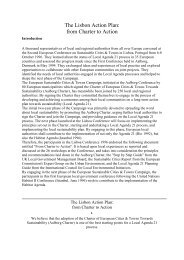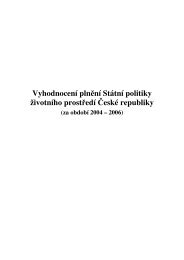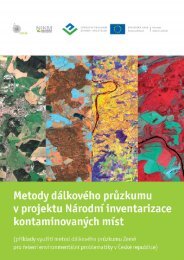Environmental Technologies and Eco-innovation in the Czech ...
Environmental Technologies and Eco-innovation in the Czech ...
Environmental Technologies and Eco-innovation in the Czech ...
Create successful ePaper yourself
Turn your PDF publications into a flip-book with our unique Google optimized e-Paper software.
TABLE 2 | Electricity generation from RES <strong>in</strong> <strong>the</strong> <strong>Czech</strong> Republic [MWh, %], 2007<br />
Renewable electricity source<br />
Gross<br />
generation<br />
of electricity<br />
[MWh]<br />
Electricity delivery<br />
to <strong>the</strong> supply<br />
network<br />
[MWh]<br />
Share <strong>in</strong> home gross<br />
consumption of<br />
electricity<br />
[%]<br />
Share<br />
<strong>in</strong> gross generation<br />
of electricity<br />
[%]<br />
Hydro power plants 2 089 600.0 2 080 800.0 2.90 2.37<br />
Biomass <strong>in</strong> total 968 062.9 403 706.1 1.34 1.10<br />
Biogas <strong>in</strong> total 215 223.0 138 485.0 0.30 0.24<br />
Municipal solid waste (MSW) 11 975.1 5 074.0 0.02 0.01<br />
W<strong>in</strong>d power plants 125 100.0 124 700.0 0.17 0.14<br />
Photovoltaic systems (estimate) 2 127.0 1 800.0 0 0<br />
Liquid biofuels 9.0 8.2 0 0<br />
RES <strong>in</strong> total 3 412 097.0 2 754 573.3 4.73 3.86<br />
SOURCE | MIT<br />
The <strong>the</strong>oretical potential of electricity generation from RES is 50 TWh <strong>in</strong> <strong>the</strong> <strong>Czech</strong><br />
Republic. 5% of this 50 TWh would be from hydraulic power plants, 12% from w<strong>in</strong>d<br />
power plants, 20% would be geo<strong>the</strong>rmal energy, 26% from biomass energy <strong>and</strong> 37%<br />
from solar energy. The actual potential, <strong>in</strong>fluenced ma<strong>in</strong>ly by economics <strong>and</strong> available<br />
locations for <strong>the</strong>se sources, is lower.<br />
2.2.1 | Hydro power plants<br />
Hydro power plants are <strong>the</strong> most exp<strong>and</strong>able facilities for energy generation from<br />
RES <strong>in</strong> <strong>the</strong> <strong>Czech</strong> Republic. Their advantage is <strong>the</strong>ir flexibility <strong>and</strong> quick start thanks<br />
to <strong>the</strong> accumulation of water energy <strong>in</strong> reservoirs. Therefore, <strong>the</strong>y significantly<br />
contribute to ma<strong>in</strong>ta<strong>in</strong><strong>in</strong>g <strong>the</strong> balance between <strong>the</strong> generation <strong>and</strong> consumption of<br />
electricity <strong>in</strong> energy grids.<br />
The share of HPP <strong>in</strong> electricity generation from RES fluctuates; generation is strongly<br />
dependent on watercourse accumulation throughout <strong>the</strong> year. Today, <strong>the</strong> annual volume<br />
of electricity deliveries from HPP hover around 2.5 TWh per year <strong>in</strong> <strong>the</strong> <strong>Czech</strong> Republic.<br />
The construction of large dams significantly impacts <strong>the</strong> l<strong>and</strong>scape <strong>and</strong> local ecosystems,<br />
<strong>and</strong> it changes microclimatic conditions <strong>in</strong> surround<strong>in</strong>g areas. Therefore, it is<br />
impossible to assume a considerable <strong>in</strong>crease <strong>in</strong> <strong>the</strong> number of large HPP <strong>in</strong> <strong>the</strong> future.
















